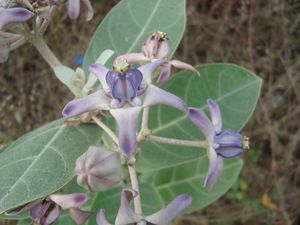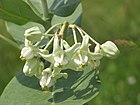Note: This is a project under development. The articles on this wiki are just being initiated and broadly incomplete. You can Help creating new pages.
Calotropis gigantea - Arka plant
Calotropis procera Ait is a large shrub growing to 4 m (13 ft) tall. It has clusters of waxy flowers that are either white or lavender in color. The plant has oval, light green leaves and milky stem. The latex of Calotropis gigantea contains cardiac glycosides, fatty acids, and calcium oxalate. Arka consists of dried roots of Calotropis procera (Ait.) R. Br. (Fam.Asclepiadaceae) found wild more or less throughout India.
Uses
Parts Used
Chemical Composition
The milky sap contains a complex mix of chemicals, some of which are steroidal heart poisons known as "cardiac aglycones". These belong to the same chemical family as similar chemicals found in foxgloves (Digitalis purpurea). The steroidal component includes an hydroxyl group in the C3β position, a second attached to the C14 carbon, a C/D-cis ring junction and an α,β-unsaturated-γ-lactone in the C17 position. In the plants, the steroidal component is commonly attached via a glycosidic link to a 2-desoxy or a 2,6-didesoxy sugar molecule
Common names
| Language | Common name |
|---|---|
| Kannada | Ekka, Ekkagida |
| Hindi | Ak, Akada, Safed-ak |
| Malayalam | Erikku |
| Tamil | Vellaerukku |
| Telugu | Nallajelledu, Mandaramu |
| Marathi | NA |
| Gujarathi | NA |
| Punjabi | NA |
| Kashmiri | NA |
| Sanskrit | Swetarka, Arka, Ravi |
| English | Madar |
Properties
Reference: Dravya - Substance, Rasa - Taste, Guna - Qualities, Veerya - Potency, Vipaka - Post-digesion effect, Karma - Pharmacological activity, Prabhava - Therepeutics.
Dravya
Rasa
Tikta (Bitter), Katu (Pungent)
Guna
Laghu (Light), Ruksha (Dry), Tikshna (Sharp)
Veerya
Ushna (Hot)
Vipaka
Katu (Pungent)
Karma
Vata, Kapha
Prabhava
Habit
Identification
Leaf
| Kind | Shape | Feature |
|---|---|---|
| milky white sap | large, relatively thick (5-30 cm long and 4-15 cm wide) | The leaves greyish-green in colour and have entire margins |
.[2]
Flower
| Type | Size | Color and composition | Stamen | More information |
|---|---|---|---|---|
| borne in clusters | 15-25 mm across | white or pinkish | five | Flowering occurs mostly during winter. |
Fruit
| Type | Size | Mass | Appearance | Seeds | More information |
|---|---|---|---|---|---|
| large | 6-12 cm long and 3-7 cm wide | These fruit have thick and spongy skins which split open at maturity | numerous brown, flattened seeds | {{{6}}} |
Other features
List of Ayurvedic medicine in which the herb is used
- Vishatinduka Taila as root juice extract
Where to get the saplings
Mode of Propagation
How to plant/cultivate
Succeeds in the drier tropics. Most commonly found in areas of the tropics with a specific dry season, at elevations up to 1,000 metres[3]
Commonly seen growing in areas
Photo Gallery
References
External Links
- Ayurvedic Herbs known to be helpful to treat Rheumatism
- Ayurvedic Herbs known to be helpful to treat painful joints
- Ayurvedic Herbs known to be helpful to treat Skin blemishes
- Ayurvedic Herbs known to be helpful to treat Leucoderma
- Ayurvedic Herbs known to be helpful to treat vitiligo
- Ayurvedic Herbs known to be helpful to treat Piles
- Ayurvedic Herbs known to be helpful to treat Pain in ears
- Herbs with Root used in medicine
- Herbs with Bark used in medicine
- Herbs with Flowers used in medicine
- Herbs with Leaf used in medicine
- Herbs with Latex used in medicine
- Herbs with common name in Kannada
- Herbs with common name in Hindi
- Herbs with common name in Malayalam
- Herbs with common name in Tamil
- Herbs with common name in Telugu
- Herbs with common name in Sanskrit
- Herbs with common name in English
- Habit - Large shrub
- Index of Plants which can be propagated by Seeds
- Index of Plants which can be propagated by Cuttings
- Index of Plants which can be propagated by Layering
- Herbs that are commonly seen in the region of trophical
- Herbs that are commonly seen in the region of indian subcontinent
- Ayurvedic Pharmacopedia of India
- Herbs









